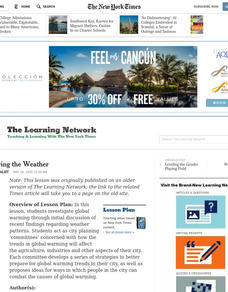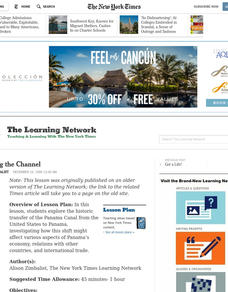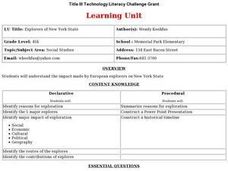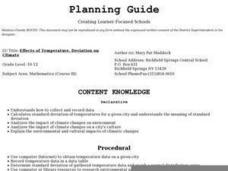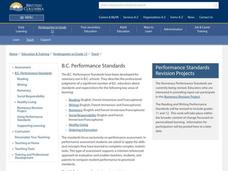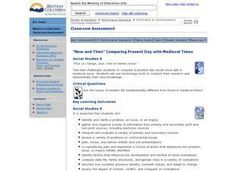Curated OER
Looking Back, Up and Ahead
Students explore how scientists have forecasted the 2002 Leonid meteor shower. They pose their own predictions for peak meteor rates per hour during the 2002 shower and compare their results with actual observed rates.
Curated OER
"Separate But Equal" Revisited
Students examine the struggle for desegregation during the Civil Rights Movement. They assess ways in which race relations have and have not changed since the Brown v. Board of Education decision.
Curated OER
The Past Is Gone, But Not Forgotten
Pupils examine the role of historic sites in preserving the past, and use a NY Times article about a preserved 19th century farm as a springboard for discussion about the conservation of other historic sites and research about historic...
Curated OER
Weathering the Weather
Students investigate global warming through initial discussion of recent findings regarding weather patterns. They act as city planning 'committees' concerned with how the trends in global warming affect the agriculture and industries.
Curated OER
Putting the Truth in Writing
Learners define "nonfiction" and describe what they view as the best pieces of nonfiction writing. They determine criteria to evaluate whether or not a piece of nonfiction writing is good, and list categories of nonfiction writing.
Curated OER
Changing the Channel
Learners explore the historic transfer of the Panama Canal from the United States to Panama, investigating how this shift might affect various aspects of Panama's economy, relations with other countries, and international trade.
Curated OER
Un-Presidented Election
Students explore the results of the 2000 presidential election. They look back at important issues in the campaign and write newspaper articles which cover specific angles on the election.
Curated OER
Explorers of New York State
Fourth graders study European explorers who made an impact of New York State. They conduct research and create a timeline and a Powerpoint presentation about one of the explorers.
Curated OER
Using Blood Tests to Identify Babies and Criminals
Students solve a crime by matching a suspect's blood type to physical evidence collected at the crime scene. In this forensic science lesson, students identify the different blood types. They explain how blood tests work.
Curated OER
Some Similarities Between the Spread of an Infectious Disease and Population Growth
Learners compare and contrast the spread of infectious diseases and population growth. In this biology lesson plan, students identify the exponential growth pattern of spreading diseases. They relate this to HIV infection and AIDS.
Curated OER
Save Our Forests
Fifth graders discuss the forest products industry and its affects upon their communities. They inventory the wood and paper products they consume and determine how it translates into the number of trees cut. Using a spreadsheet, they...
Curated OER
Web Page Creation
Students complete a unit of lessons on web pages and web page creation. They conduct Internet research, identify the characteristics of effective and ineffective websites, construct a glossary of terms, and develop three web pages.
Curated OER
Effects of Temperature, Deviation on Climate
Young scholars collect and record data for a given city. They calculate standard deviation of temperature and analyze the impact of climate changes on a city's and culture.
Curated OER
Describing Patterns
Fourth graders investigate repeating and growing patterns. Models, graphs and words are used to describe, extend and represent patterns. Students use evidence from models and graphs to support the identification of patterns.
Curated OER
Refugees
Sixth graders use the internet as well as personal interviews to research refugees and refugee status from a Canadian and international perspective.
Curated OER
Childhood Obesity
Students identify a question to generate appropriate data and predict results. They distinguish between a total population and a sample and use a variety of methods to collect and record data. Students create classifications and ranges...
Curated OER
"Now and Then" Comparing Present Day with Medieval Times
Eighth graders compare a present-day social issue with a medieval issue. They use technology tools to conduct their research and demonstrate their new knowledge. Students present their findings to the class in the form of a PowerPoint.
Curated OER
Reading Research!
Young scholars observe the pictures in non-fiction books that focus on animals in the winter. In addition, they also listed to some read aloud books about hibernation, migration, adaptation and dormancy. Students draw pictures and write...
Curated OER
Imperial Units
In this converting imperial units worksheet, students complete converting 12 metric units from imperial units to metric or vice versa.
Curated OER
The Fear Place
Students use the strategy turn and talk to discuss inferences they have while reading the book The Fear Place. In this inferences lesson plan, students answer discussion questions and read independently as well.
Curated OER
Translating Word Phrases into Algebraic Expressions
Pupils view a PowerPoint and practice writing algebraic expressions from word phrases. In this algebra lesson, students utilize phrases such as, "plus, minus, sum, difference, increased by and subtracted from." There are 5 problems on...
Curated OER
Reading Short Stories
In this graphic organizer worksheet, students fill in the graphic organizer with the predictions, settings, characters, background, and more for short stories. Students complete 5 sections.
Curated OER
Come Fly With Me...Aviation
Students conduct internet research on aviation and pioneer aviators. They create an alphabet book r with flight related terms, write a short biography of a pioneer aviator and take part in a paper plane flying contest.
Curated OER
Myths and Folk Tales
Seventh graders perform research in order to appreciate stories taken from the genre of myths and fables. The examples of the stories create a context for students to create their own myths.





